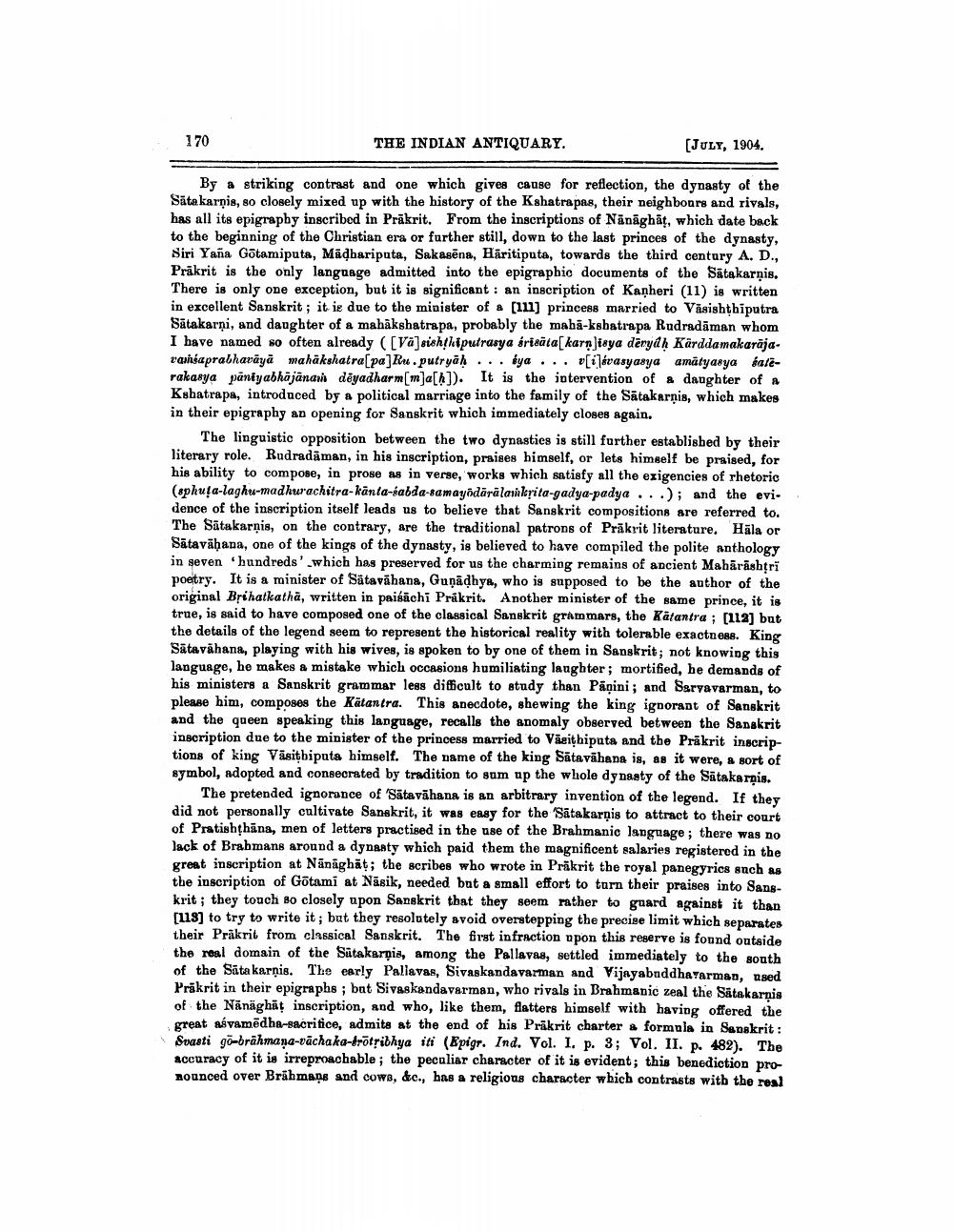________________
170
THE INDIAN ANTIQUARY.
[JULY, 1904.
By a striking contrast and one which gives cause for reflection, the dynasty of the Satakarnis, so closely mixed up with the history of the Kshatrapas, their neighbours and rivals, has all its epigraphy inscribed in Prakrit. From the inscriptions of Nanaghat, which date back to the beginning of the Christian era or further still, down to the last princes of the dynasty, Siri Yaña Gotamiputa, Madhariputa, Sakasēna, Haritiputa, towards the third century A. D., Prakrit is the only language admitted into the epigraphic documents of the Satakarnis. There is only one exception, but it is significant: an inscription of Kanheri (11) is written in excellent Sanskrit; it is due to the minister of a [111] princess married to Vasishthiputra Satakarni, and daughter of a mahakshatrapa, probably the maha-kshatrapa Rudradāman whom I have named so often already ([Va]sishthiputrasya srisata[karn]isya deryaḥ Kärddamakarājavaniaprabhavaya mahakshatra [pa] Ru.putryah ya... viivasyasya amatyasya baterakasya paniyabhajanam deyadharm[m]a[h]). It is the intervention of a daughter of a Kshatrapa, introduced by a political marriage into the family of the Satakarnis, which makes in their epigraphy an opening for Sanskrit which immediately closes again.
The linguistic opposition between the two dynasties is still further established by their literary role. Rudradaman, in his inscription, praises himself, or lets himself be praised, for his ability to compose, in prose as in verse, works which satisfy all the exigencies of rhetoric (sphuta-laghu-madhurachitra-kanta-iabda-samayndārālamkrita-gadya-padya...); and the evidence of the inscription itself leads us to believe that Sanskrit compositions are referred to. The Satakarnis, on the contrary, are the traditional patrons of Prakrit literature. Hala or Satavahana, one of the kings of the dynasty, is believed to have compiled the polite anthology in seven hundreds' which has preserved for us the charming remains of ancient Maharashtrï poetry. It is a minister of Satavahana, Guṇādhya, who is supposed to be the author of the original Brihatkatha, written in paiśachi Prakrit. Another minister of the same prince, it is true, is said to have composed one of the classical Sanskrit grammars, the Katantra; [112] but the details of the legend seem to represent the historical reality with tolerable exactness. King Satavahana, playing with his wives, is spoken to by one of them in Sanskrit; not knowing this language, he makes a mistake which occasions humiliating laughter; mortified, he demands of his ministers a Sanskrit grammar less difficult to study than Panini; and Sarvavarman, to please him, composes the Katantra. This anecdote, shewing the king ignorant of Sanskrit and the queen speaking this language, recalls the anomaly observed between the Sanskrit inscription due to the minister of the princess married to Vasithiputa and the Präkrit inscriptions of king Väsithiputa himself. The name of the king Satavahana is, as it were, a sort of symbol, adopted and consecrated by tradition to sum up the whole dynasty of the Satakarnis.
The pretended ignorance of 'Satavahana is an arbitrary invention of the legend. If they did not personally cultivate Sanskrit, it was easy for the Satakarnis to attract to their court of Pratishthana, men of letters practised in the use of the Brahmanic language; there was no lack of Brahmans around a dynasty which paid them the magnificent salaries registered in the great inscription at Nanaghat; the scribes who wrote in Prakrit the royal panegyrics such as the inscription of Götami at Nasik, needed but a small effort to turn their praises into Sanskrit; they touch so closely upon Sanskrit that they seem rather to guard against it than [118] to try to write it; but they resolutely avoid overstepping the precise limit which separates their Prakrit from classical Sanskrit. The first infraction upon this reserve is found outside the real domain of the Satakarnis, among the Pallavas, settled immediately to the south of the Satakarnis. The early Pallavas, Sivaskandavarman and Vijayabuddhavarman, used Prakrit in their epigraphs; but Sivaskandavarman, who rivals in Brahmanic zeal the Satakarnis of the Nänäghat inscription, and who, like them, flatters himself with having offered the great aśvamedha-sacrifice, admits at the end of his Prakrit charter a formula in Sanskrit: Svasti gö-brāhmaṇa-vāchaka-brotṛibhya iti (Epigr. Ind. Vol. I. p. 3; Vol. II. p. 482). The accuracy of it is irreproachable; the peculiar character of it is evident; this benediction pronounced over Brahmans and cows, &c., has a religious character which contrasts with the real




